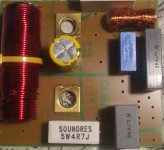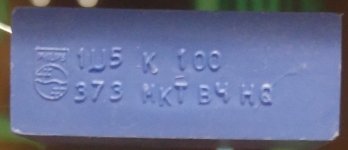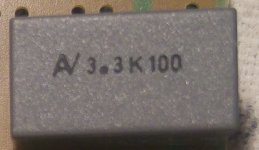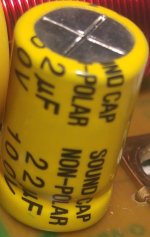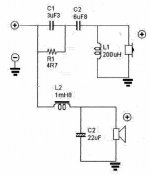Hi guys.
I got these Italian speakers for 150$. They are about 15 years old now (if I am not wrong).
Box build is very sold and nice. Drivers are less nice as I understand.
Woofer basket is made of plastic Tweeter is really small thing, not impressive. Can post pictures if you want.
Tweeter is really small thing, not impressive. Can post pictures if you want.
I am trying to get out of them the best they can give.
Currently they sound like some high frequencies are being played through woofer (some dull muddy sound) and not through tweeter as they should. I connected tweeter from other speaker and got the same result. I get such sound on both speakers, not on only one.
I don't think these Chario guys released such sounding speakers to market, so I guess there is some problem with them and problem is located in crossovers.
As I know first thing I can do is just go and recap them both. Sounds like a simple job for some of you, but not to beginner like me
I took crossovers out without a problem, but I am having troubles on identifying components and their values.
So I need to get:
1) List of capacitors with their values.
2) Any advises from you if I should use some better components then currently installed (almost generic) ones.
Thanks a lot!
------------------------------------------------------------------------------------------------------------------------------------------
Update to summarize the thread:
We decided not to touch any of capacitors except yellow one (bipolar electrolytic capacitor 22uf 100V).
Currently I replaced old yellow capacitors by ELNA RDB 100V 22uf bipolar right now.
Sound seems OK to me.
All modern low loss capacitors (MKP or electrolytic capacitors) are not relevant here.
They kill the bass and spoil mid range. We need to have high ESR electrolytic capacitor here (preferably old designs).
If someone is going to do such replacement for this speaker (or for other Chario), then please try to go with capacitors similar to
ELNA RDB (this is new model available to purchase):
https://hfc-fs.s3-eu-west-1.amazonaw...a_rbd_data.pdf
OR ELNA CERAFINE bipolar (old model which is not available to purchase):
http://www.elna-america.com/products/pdf_files/AL/ROA.pdf
Post updates here on your experience of replacements to any other kinds of capacitors. I will be glad to read.
I got these Italian speakers for 150$. They are about 15 years old now (if I am not wrong).
Box build is very sold and nice. Drivers are less nice as I understand.
Woofer basket is made of plastic
I am trying to get out of them the best they can give.
Currently they sound like some high frequencies are being played through woofer (some dull muddy sound) and not through tweeter as they should. I connected tweeter from other speaker and got the same result. I get such sound on both speakers, not on only one.
I don't think these Chario guys released such sounding speakers to market, so I guess there is some problem with them and problem is located in crossovers.
As I know first thing I can do is just go and recap them both. Sounds like a simple job for some of you, but not to beginner like me
I took crossovers out without a problem, but I am having troubles on identifying components and their values.
So I need to get:
1) List of capacitors with their values.
2) Any advises from you if I should use some better components then currently installed (almost generic) ones.
Thanks a lot!
------------------------------------------------------------------------------------------------------------------------------------------
Update to summarize the thread:
We decided not to touch any of capacitors except yellow one (bipolar electrolytic capacitor 22uf 100V).
Currently I replaced old yellow capacitors by ELNA RDB 100V 22uf bipolar right now.
Sound seems OK to me.
All modern low loss capacitors (MKP or electrolytic capacitors) are not relevant here.
They kill the bass and spoil mid range. We need to have high ESR electrolytic capacitor here (preferably old designs).
If someone is going to do such replacement for this speaker (or for other Chario), then please try to go with capacitors similar to
ELNA RDB (this is new model available to purchase):
https://hfc-fs.s3-eu-west-1.amazonaw...a_rbd_data.pdf
OR ELNA CERAFINE bipolar (old model which is not available to purchase):
http://www.elna-america.com/products/pdf_files/AL/ROA.pdf
Post updates here on your experience of replacements to any other kinds of capacitors. I will be glad to read.
Attachments
Last edited:
At the top of the first pic, is that another cap ?
Otherwise I see one electrolytic and three polyester.
IF you really want to do this.
Use polypropylene.
But be aware they will all be far bigger than what is there now.
1. All the values are written or stamped on them in plain sight.
2. Everyone will have their own opinion as to whether you 'need' to replace any of those capacitors.
Otherwise I see one electrolytic and three polyester.
IF you really want to do this.
Use polypropylene.
But be aware they will all be far bigger than what is there now.
1. All the values are written or stamped on them in plain sight.
2. Everyone will have their own opinion as to whether you 'need' to replace any of those capacitors.
At the top of the first pic, is that another cap ?
Otherwise I see one electrolytic and three polyester.
IF you really want to do this.
Use polypropylene.
But be aware they will all be far bigger than what is there now.
1. All the values are written or stamped on them in plain sight.
2. Everyone will have their own opinion as to whether you 'need' to replace any of those capacitors.
Thank you for your answer.
0. At the top there is a connector to connect drivers, not a capacitor.
Why do you suggest polypropylene instead of polyester?
You suggest also polypropylene instead of electrolytic one too?
1. "Plain sight" is for your eyes, sir, not for mine
Can I maybe summarize what I understand and you will correct me?
a) yellow: "Soundcap" non-polar electrolytic capacitor 22uf
b) blue: "Philips" polyester capacitor, not sure what is the value here?
c) grey long: "AV" polyester capacitor 4.7 uf 63V , not sure what k means here (some part of the model)
d) grey short: "AV" polyester capacitor 3.3 uf 100V not sure what k means here (some part of the model)
2. I can always try new version of crossover and then return to original parts, so its just matter of time and investment from my side. But I am not scared to do this job any way - it will be good experience for me overall.
Last edited:
I meant... the only cap that would need replacing....
Why is that? Do you think that other caps are not degrading? Can not be worn out by extensive usage?
not sure what k means here (some part of the model)
d) grey short: "AV" polyester capacitor 3.3 uf 100V not sure what k means here (some part of the model)
J = 5% tolerance
K = 10 % tolerance
J = 5% tolerance
K = 10 % tolerance
Thanks for clarification!
Thank you for your answer.
0. At the top there is a connector to connect drivers, not a capacitor.
Fair enough then
Why do you suggest polypropylene instead of polyester?
You suggest also polypropylene instead of electrolytic one too?
A little bit of research will illuminate your way
1. "Plain sight" is for your eyes, sir, not for mine
Can I maybe summarize what I understand and you will correct me?
a) yellow: "Soundcap" non-polar electrolytic capacitor 22uf
b) blue: "Philips" polyester capacitor, not sure what is the value here?
c) grey long: "AV" polyester capacitor 4.7 uf 63V , not sure what k means here (some part of the model)
d) grey short: "AV" polyester capacitor 3.3 uf 100V not sure what k means here (some part of the model)
See. It is in plain sight. You got them all right.
The blue one is indeed labeled.
Come on, you can do it
2. I can always try new version of crossover and then return to original parts, so its just matter of time and investment from my side. But I am not scared to do this job any way - it will be good experience for me overall.
Part of the fun is the researching and learning.
OK, I found that blue capacitor is marked according to IEC 60062 and capacitance there is 1.5uf!
So for now:
a) yellow: "Soundcap" non-polar electrolytic capacitor 22uf
b) blue: "Philips" metalized polyester film (MKT) capacitor, 1.5uf, 10% tolerance, 100V, HQ factory of origin, Manufacturer’s type designation 373, B4 is probably code of production
c) grey long: "AV" polyester capacitor 4.7 uf 63V , 10% tolerance
d) grey short: "AV" polyester capacitor 3.3 uf 100V, 10% tolerance
Many people say that polyester capacitors are not dying that fast, so I will and replace first only yellow capacitors and see what will happen to sound
Thanks for your help, guys.
Especially to UserAbuser for "Come on, you can do it".
I really can!
So for now:
a) yellow: "Soundcap" non-polar electrolytic capacitor 22uf
b) blue: "Philips" metalized polyester film (MKT) capacitor, 1.5uf, 10% tolerance, 100V, HQ factory of origin, Manufacturer’s type designation 373, B4 is probably code of production
c) grey long: "AV" polyester capacitor 4.7 uf 63V , 10% tolerance
d) grey short: "AV" polyester capacitor 3.3 uf 100V, 10% tolerance
Many people say that polyester capacitors are not dying that fast, so I will and replace first only yellow capacitors and see what will happen to sound
Thanks for your help, guys.
Especially to UserAbuser for "Come on, you can do it".
I really can!
Trying to pick up correct capacitors for the job 
Crossover manufacturer (SET Crossover Network) were very nice to me and gave me schema of my crossover.
I need to sit and draw schematics from actual crossover that I have to make sure it is really same (or almost the same) as provided by SET schema. And here is why.
On provided schema I have capacitor of size 6.8 uf (C2 at the top of schema).
This one does not appear on actual crossover. In its place I have two capacitors in parallel - Blue 1.5 uf 100V and gray 4.7 uf 63 V (6.2 uf in total).
Manufacturer or some master probably had no exact capacitor available for the job and put these two instead of correct one.
Can be?
This 0.6 uf difference on this capacitor can be reason why I think that voices are played more through woofer and less through tweeter - tweeter is not getting lower frequencies as HPF is moved slightly to higher end of frequencies.
Do you think I am right?
Any way I will go with one specified in schema.
Thinking of following options for capacitors:
Option one (Capacitors MKP Mundorf MCap EVO Aluminium in Oil axial 450 VDC 3%), sure can be overkill
1) Instead of Yellow 22 -> Capacitor MKP Mundorf MCap EVO Aluminium in Oil axial 450 VDC 22 uF (MEO-22T3.450)
2) Instead of Blue 1.5 + Grey 4.7 -> Capacitor MKP Mundorf MCap EVO Aluminium in Oil axial 450 VDC 6,8 uF (MEO-6,80T3.450)
3) Instead of Grey 3.3 -> Capacitor MKP Mundorf MCap EVO Aluminium in Oil axial 450 VDC 3,3 uF (MEO-3,30T3.450)
Total cost for 6 capacitors US $104.37 including shipping (Ebay).
Option two(Capacitors MKP Mundorf MCap250 Capacitors 5%)
1) Instead of Yellow 22 -> Capacitor Capacitor MKP Mundorf MCap 250 VDC 22 uF (MCap250-22)
2) Instead of Blue 1.5 + Grey 4.7 -> Capacitor Capacitor MKP Mundorf MCap 250 VDC 6,8 uF (MCap250-6,8)
3) Instead of Grey 3.3 -> Capacitor Capacitor MKP Mundorf MCap 250 VDC 6,8 uF (MCap250-6,8)
Total cost for 6 capacitors US $53.53 including shipping (Ebay).
Do you think these caps are suitable?
Should I go with another options?
Option two can be overkill because these speakers went through 15 years of usage, so drivers can be not in really good shape, so I am afraid that they their flaws will spoil any fine sound that can possible created by MCap EVO Aluminium Oil 450. What do you think?
Is it OK to buy these caps off Ebay?
I looked on mundorf.com and saw there prices higher then these I am getting from this guy on ebay. Any way he has a lot of sales there, relatively good feedbacks (on capacitors).
Thanks.
Crossover manufacturer (SET Crossover Network) were very nice to me and gave me schema of my crossover.
I need to sit and draw schematics from actual crossover that I have to make sure it is really same (or almost the same) as provided by SET schema. And here is why.
On provided schema I have capacitor of size 6.8 uf (C2 at the top of schema).
This one does not appear on actual crossover. In its place I have two capacitors in parallel - Blue 1.5 uf 100V and gray 4.7 uf 63 V (6.2 uf in total).
Manufacturer or some master probably had no exact capacitor available for the job and put these two instead of correct one.
Can be?
This 0.6 uf difference on this capacitor can be reason why I think that voices are played more through woofer and less through tweeter - tweeter is not getting lower frequencies as HPF is moved slightly to higher end of frequencies.
Do you think I am right?
Any way I will go with one specified in schema.
Thinking of following options for capacitors:
Option one (Capacitors MKP Mundorf MCap EVO Aluminium in Oil axial 450 VDC 3%), sure can be overkill
1) Instead of Yellow 22 -> Capacitor MKP Mundorf MCap EVO Aluminium in Oil axial 450 VDC 22 uF (MEO-22T3.450)
2) Instead of Blue 1.5 + Grey 4.7 -> Capacitor MKP Mundorf MCap EVO Aluminium in Oil axial 450 VDC 6,8 uF (MEO-6,80T3.450)
3) Instead of Grey 3.3 -> Capacitor MKP Mundorf MCap EVO Aluminium in Oil axial 450 VDC 3,3 uF (MEO-3,30T3.450)
Total cost for 6 capacitors US $104.37 including shipping (Ebay).
Option two(Capacitors MKP Mundorf MCap250 Capacitors 5%)
1) Instead of Yellow 22 -> Capacitor Capacitor MKP Mundorf MCap 250 VDC 22 uF (MCap250-22)
2) Instead of Blue 1.5 + Grey 4.7 -> Capacitor Capacitor MKP Mundorf MCap 250 VDC 6,8 uF (MCap250-6,8)
3) Instead of Grey 3.3 -> Capacitor Capacitor MKP Mundorf MCap 250 VDC 6,8 uF (MCap250-6,8)
Total cost for 6 capacitors US $53.53 including shipping (Ebay).
Do you think these caps are suitable?
Should I go with another options?
Option two can be overkill because these speakers went through 15 years of usage, so drivers can be not in really good shape, so I am afraid that they their flaws will spoil any fine sound that can possible created by MCap EVO Aluminium Oil 450. What do you think?
Is it OK to buy these caps off Ebay?
I looked on mundorf.com and saw there prices higher then these I am getting from this guy on ebay. Any way he has a lot of sales there, relatively good feedbacks (on capacitors).
Thanks.
Attachments
Last edited:
Sorry, Long post 
In short, use what your happy to use.
With time and experience you will find what works for you.
..........................
Excellent.
You did the work and get the rewards of learning.
Young grasshopper has come far
Yes it's a 1u5.
European labelling for a 1.5uF
Polyester and polypropylene are classed as film capacitors.
They do not have a liquid electrolyte like the yellow electrolytic cap.
As such film caps do not suffer from age related issues.
These issues are from the electrolyte drying out or leaking out.
Polypropylene caps are regarded as being a better 'sounding' cap than polyester.
** Note that every man and his cat has their own personal favourite cap or theory why they do or don't make a difference in sound **
The Mundorf M-cap I find ok, but I think Jantzen Cross-caps would be a little better.
I openly admit I like Jantzen products.
Their Cross-cap is a budget friendly polypropylene that I personally think would be a good starting 'upgrade' for any of the caps in your first speaker project.
Others will disagree. That's fine. To each their own.
I wouldn't buy from ebay. To many possible risks.
If you tell us where on earth you are, we could recommend some places nearby.
Before you start buying.
Please have a look at the physical size of any replacement cap.
You will find most are way bigger than what is there now.
The issues you mention of 'drivers not in good shape' I will disregard.
Unless the driver has been seriously abused, it should still be fine.
One of my pairs of speakers are over 40 years old and still sound as they did when new.
You mention 'voices' from the bass driver.
It looks like the crossover point will be fairly high on your speakers.
So that's what I'd expect them to sound like.
Changing the caps will not 'fix' that because that's how they were designed.
Yes sometimes manufacturers will use parallel caps to get the value they want.
Sometimes schematics won't be the same as the product you have due to running changes during production.
I once rebuilt a pair of crossovers for the exact same model of speaker.
The left one had totally a different crossover from the right one.
Yet the serial numbers were only a few numbers apart.
This model had three revisions through their life time.
I'm glossing over a lot of details and info here.
Your a beginner. To much info will make you run away screaming
In short, use what your happy to use.
With time and experience you will find what works for you.
..........................
Excellent.
You did the work and get the rewards of learning.
Young grasshopper has come far
Yes it's a 1u5.
European labelling for a 1.5uF
Polyester and polypropylene are classed as film capacitors.
They do not have a liquid electrolyte like the yellow electrolytic cap.
As such film caps do not suffer from age related issues.
These issues are from the electrolyte drying out or leaking out.
Polypropylene caps are regarded as being a better 'sounding' cap than polyester.
** Note that every man and his cat has their own personal favourite cap or theory why they do or don't make a difference in sound **
The Mundorf M-cap I find ok, but I think Jantzen Cross-caps would be a little better.
I openly admit I like Jantzen products.
Their Cross-cap is a budget friendly polypropylene that I personally think would be a good starting 'upgrade' for any of the caps in your first speaker project.
Others will disagree. That's fine. To each their own.
I wouldn't buy from ebay. To many possible risks.
If you tell us where on earth you are, we could recommend some places nearby.
Before you start buying.
Please have a look at the physical size of any replacement cap.
You will find most are way bigger than what is there now.
The issues you mention of 'drivers not in good shape' I will disregard.
Unless the driver has been seriously abused, it should still be fine.
One of my pairs of speakers are over 40 years old and still sound as they did when new.
You mention 'voices' from the bass driver.
It looks like the crossover point will be fairly high on your speakers.
So that's what I'd expect them to sound like.
Changing the caps will not 'fix' that because that's how they were designed.
Yes sometimes manufacturers will use parallel caps to get the value they want.
Sometimes schematics won't be the same as the product you have due to running changes during production.
I once rebuilt a pair of crossovers for the exact same model of speaker.
The left one had totally a different crossover from the right one.
Yet the serial numbers were only a few numbers apart.
This model had three revisions through their life time.
I'm glossing over a lot of details and info here.
Your a beginner. To much info will make you run away screaming
I would only replece the yellow electrolyte with a similar fimcap, and the suggested Jantzen Crosscap is also what i would use. The rest are decent quality film caps and don't age so don't have to be replaced. And the board seems to be in good state, so i don't think you need to throw away half of it.
Thanks for that length reply. Read every letter of it, enjoyed.
About voices issue.
I think I did not explain myself good enough. Will try now.
Here is my understanding of things.
By design my speakers crossover frequency is 1650 hz.
So, sure part of frequencies responsible for voice reproduction will surely go through woofer driver.
But good part of voice frequencies should go also through tweeter.
And this good part heavily depends on values of two tweeter filtering capacitors - C1 (3.3uf) and C2 (6.8uf) at the top of schema.
Now, what will happen if someone puts C2 (6.2) instead of C2 (6.8) ?
I think that crossover LPF filter for tweeter will move its slope to the right - to higher frequencies, part of voices frequencies at left (in lower frequencies region). In other words tweeter will not longer reproduce lower region frequencies - these that he reproduced with correct value of C2 (6.8).
So, what I hear when I say that voices are too week is lack of these lower frequencies on tweeter.
On other hand hearing voices is not very good symptom to anyone. Maybe its good that I don't hear them good
About voices issue.
You mention 'voices' from the bass driver.
It looks like the crossover point will be fairly high on your speakers.
So that's what I'd expect them to sound like.
Changing the caps will not 'fix' that because that's how they were designed.
I think I did not explain myself good enough. Will try now.
Here is my understanding of things.
By design my speakers crossover frequency is 1650 hz.
So, sure part of frequencies responsible for voice reproduction will surely go through woofer driver.
But good part of voice frequencies should go also through tweeter.
And this good part heavily depends on values of two tweeter filtering capacitors - C1 (3.3uf) and C2 (6.8uf) at the top of schema.
Now, what will happen if someone puts C2 (6.2) instead of C2 (6.8) ?
I think that crossover LPF filter for tweeter will move its slope to the right - to higher frequencies, part of voices frequencies at left (in lower frequencies region). In other words tweeter will not longer reproduce lower region frequencies - these that he reproduced with correct value of C2 (6.8).
So, what I hear when I say that voices are too week is lack of these lower frequencies on tweeter.
On other hand hearing voices is not very good symptom to anyone. Maybe its good that I don't hear them good
I would only replece the yellow electrolyte with a similar fimcap, and the suggested Jantzen Crosscap is also what i would use. The rest are decent quality film caps and don't age so don't have to be replaced. And the board seems to be in good state, so i don't think you need to throw away half of it.
I see what you mean.
But on other hand I can put some "better sounding" capacitors for not really big money and have a chance that they will really sound good for me.
If you look on schema you will see that I want to replace two parallel capacitors (when one of them has not correct value!) with one. I think this can give some positive results.
Also try to read my previous post about voices reproduction to understand why I still want to replace almost all of them.
One more question about single electrolytic capacitor I have in schema.
It is wired in parallel to woofer/mid-bass driver.
As I understand this capacitor main purpose is to do impedance correction so LPF filter will work better.
If so, then replacing this capacitor with film capacitor will affect this impedance correction mechanism - just because film capacitor has different ESR.
Tried to read about ESR of electrolytic capacitors vs ESR of film capacitors, but did not understand much by now.
Do you guys think that this can be an issue in replacing this electrolytic capacitor with MKP capacitor?
I guess I need to add some resistor in series with this MKP to compensate lost ESR value.
It is wired in parallel to woofer/mid-bass driver.
As I understand this capacitor main purpose is to do impedance correction so LPF filter will work better.
If so, then replacing this capacitor with film capacitor will affect this impedance correction mechanism - just because film capacitor has different ESR.
Tried to read about ESR of electrolytic capacitors vs ESR of film capacitors, but did not understand much by now.
Do you guys think that this can be an issue in replacing this electrolytic capacitor with MKP capacitor?
I guess I need to add some resistor in series with this MKP to compensate lost ESR value.
The yellow cap is the most dangerous one to replace!! 
It's not just electrolytic vs. film, but 1980's caps vs. modern too. Honestly they tend to be much better.
I would strongly suggest you measure the ESR of the cap before replacing, and add missing R. Mistakes here can lead to unfortunate tanking of the impedance curve. The fact that it has NO resistor in series with it makes me believe it could have a naturally high ESR value.
You can also validate your work by measuring the impedance of the entire speaker before and after.
You can buy Dayton DATS or use a jig with Room EQ Wizard:
Impedance Measurement
It's not just electrolytic vs. film, but 1980's caps vs. modern too. Honestly they tend to be much better.
I would strongly suggest you measure the ESR of the cap before replacing, and add missing R. Mistakes here can lead to unfortunate tanking of the impedance curve. The fact that it has NO resistor in series with it makes me believe it could have a naturally high ESR value.
You can also validate your work by measuring the impedance of the entire speaker before and after.
You can buy Dayton DATS or use a jig with Room EQ Wizard:
Impedance Measurement
+1 with Waxx and Erisquires
15 years is not that too much long for a lytic, so esr can be measured and will be a little worse than if it was new... The capacitance should not have move already and perhaps they choose a radial cap for the specific inductance of it and indeed the specific esr (sort of zobel?). You really have to know how it is measuring... 22 uF exactly ? concistency number after checking the two speakers for this yellow cap ?
check also if the tweeter has Ferrofluid, if yes try to know the grade and go for a little refurbishing here...
leave in place the polyester please, this choice is not by chance... mainly the Philips.
15 years is not that too much long for a lytic, so esr can be measured and will be a little worse than if it was new... The capacitance should not have move already and perhaps they choose a radial cap for the specific inductance of it and indeed the specific esr (sort of zobel?). You really have to know how it is measuring... 22 uF exactly ? concistency number after checking the two speakers for this yellow cap ?
check also if the tweeter has Ferrofluid, if yes try to know the grade and go for a little refurbishing here...
leave in place the polyester please, this choice is not by chance... mainly the Philips.
- Status
- This old topic is closed. If you want to reopen this topic, contact a moderator using the "Report Post" button.
- Home
- Loudspeakers
- Multi-Way
- chario silhouette 100 crossover recap?
